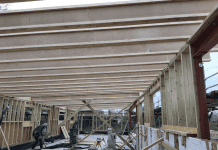Well, not quite the only solution but offsite is certainly a solution that can shake things up, says Ian Pannell of Buildoffsite
If you looked no further than last spring’s Housing White Paper, the London Mayor’s recent consultation document, the Autumn Budget and, most recently, the government’s Industrial Strategy White Paper, you could be forgiven for concluding that an offsite magic bullet is the answer – now what was the question?
As an organisation that exists to enable the widest possible take-up of offsite construction methods, Buildoffsite is naturally anxious that offsite solutions should thrive in all sectors of the construction market, including housing.
The mood music has certainly changed over the last few years. At one time, offsite was often regarded as a fringe activity that worked for cash register businesses such as hotels and supermarkets but somehow was not quite right for other markets. This qualification has rapidly been lost as manufacturers and constructors at the leading edge have delivered buildings and structures that delighted clients, delivered construction that performed as specified, reduced levels of waste and usually came in faster and to budget. Suddenly, in almost all sectors and in almost all locations, the rationale for a fundamental shift in favour of design and construction using offsite components became an entirely acceptable basis for project discussion. It’s just a shame it has taken so long for clients and suppliers to get there.
The one exception to this Damascene Conversion has been the housing sector. The fundamental reason being that, until recently, the brilliance with which housebuilders have managed their material and labour supply chains to deliver what are usually one-off, traditionally constructed projects at a price that was simply unbeatable. Traditional construction methods involve site labour and commodity products but the process does not need to bear the cost of developing and operating the sort of new factories that are needed to manufacture quality offsite components. That the quality and performance of factory-manufactured components will be superior to traditionally constructed components is not challenged but, to date, has also not been regarded as particularly compelling. Customers generally do not have a voice in market that they are rarely able to influence.
So let’s move on a bit. The housing sales started to increase a bit from historic low levels of activity but almost immediately, shortages of materials led to significant increases in prices and uncertainties regarding delivery. Labour rates started to shoot up and housebuilders had no option but to dip into the increasingly expensive pool of labour that also works on non-housing projects. Result: housebuilder interest in the potential of offsite solutions suddenly started to ramp up.
That’s essentially a Darwinian response but, from a narrow Buildoffsite viewpoint, it matters not how the motivation has developed. That housing is now firmly part of the potential offsite marketplace is positive, notwithstanding that it will continue to be a tough place in which to operate.
The recent Budget Statement set out an ambition for UK housebuilding to expand to deliver an additional 300,000 homes a year by the mid-2020s compared with the 217,000 homes delivered in 2016-17. Conveniently, government has pitched the target date into the period of the parliament after next. That is a very long term in political careers. In a UK context, the target is a very large and challenging number but one that industry pundits, including Buildoffsite, have been advocating for years. It is also a target that has not been achieved in decades. When it was last achieved, it was as a result of a substantial public sector investment in early generation industrial building technology. A clear message here.
The headlines have made much of the return of council housing and indeed, many local authorities are ultra-keen to take on a property development role to deliver a mix of homes for social rent and homes for private sale or shared ownership. Many of these authorities are also looking to optimise their use of offsite solutions to deliver quality homes at scale. They will need to be on a rapid learning curve to understand what behaviours they need to adopt to get the best out of offsite solutions and work in ways that encourage offsite manufacturers to want to win their work at a time when alternative markets for their products remain strong. Much the same applies to those housing associations who also want to step up their housebuilding programmes.
The small print of the Budget contained a lot of information over and above the headline figures that made it into the mainstream media. The headline investment figure of £44bn (that’s nine digits, by the way) covers a five-year period and includes £15.3bn of new money. More than half of this new money is earmarked for financial guarantees for private sector housebuilding. Loans to SME builders to support housebuilding amount to £1.5bn, grants to local authorities for strategic enabling infrastructure are set at £2.5bn and £1bn of additional borrowing is being made available for local authorities to build new homes.
The bottom line here is that although the numbers are mind bogglingly huge, the reality is that to get anywhere near to the 300,000 target it will require an increasingly strong role for the private sector and sustained confidence in home ownership.
It will also require the wholesale adoption of offsite construction methods. Unusually, recent government announcements have also recognised that the
construction industry needs help to become more innovative and more productive. The headline figure is that an additional £170m will be made available through the Industrial Strategy Challenge Fund, as well as extra money for upskilling. That’s welcome – notwithstanding that the detail is still awaited.
The runes look good for sustained growth in the application of offsite construction in all markets, including housing. There is also a substantial stream of investment in new manufacturing capacity that will substantially boost UK capacity. As always, the challenge will be in ensuring that potential markets become actual markets. The government is saying all the right things but needs to play a full part in supporting a market development that the UK needs if the housing target is to be achievable. The government will win no prizes if it simply sits back and assumes that innovation, increased productivity and indeed housing numbers will just happen.
Buildoffsite has set up a Housing Hub to support and enable the evolution of an offsite-enabled market for the homes that the UK needs. Recent events have been supported by the GLA and by L&G. These important B2B events have been reported in Buildoffsite newsletters, which are available online.
For more information on the work of the Buildoffsite Housing Hub and to find out how to get involved visit www.buildoffsite.com.
 Ian Pannell
Ian Pannell
Buildoffsite
Tel: +44 (0)20 7549 3306
info@buildoffsite.com
Twitter: @buildoffsite

















